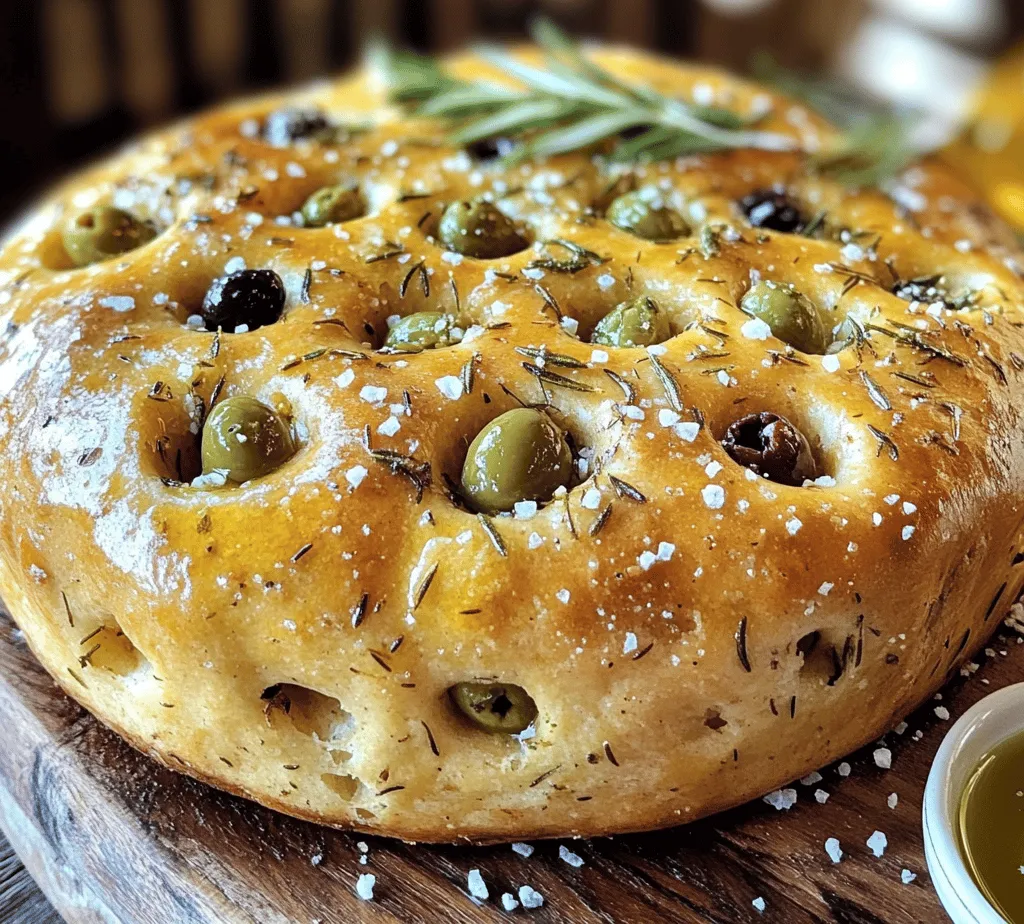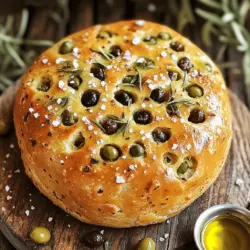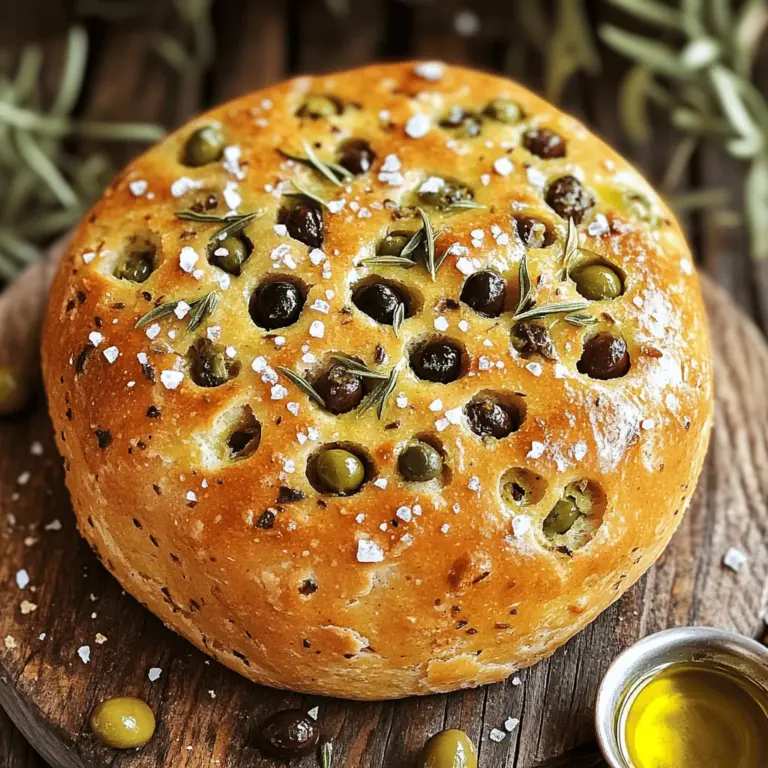Introduction
There’s something truly magical about the process of making homemade bread. The aroma of freshly baked loaves wafting through the kitchen, the anticipation of slicing into a warm, crusty exterior to reveal a soft, flavorful interior—it’s an experience that tantalizes the senses. Among the many varieties of bread, the Savory Olive Bread Delight stands out as a perfect blend of robust flavors and delightful textures. Infused with the rich essence of mixed olives, aromatic herbs, and high-quality olive oil, this bread is not only a treat for the taste buds but also a wholesome addition to any meal.
This savory bread is incredibly versatile; it can be served as an appetizer, a side dish, or even as the star of your cheese platter. Imagine hosting a dinner party where your guests are greeted with a warm loaf of Savory Olive Bread, its inviting scent enveloping them as they gather around the table. Whether paired with a hearty soup, enjoyed with a glass of wine, or simply savored on its own, this bread will undoubtedly elevate your dining experience.
In this article, we will dive into the key ingredients that make this bread exceptional, the science behind the bread-making process, and provide you with a detailed step-by-step guide to creating your very own Savory Olive Bread Delight. Let’s embark on this culinary adventure together!
Understanding the Key Ingredients
Exploring the Role of Flour in Bread Making
At the heart of any good bread lies flour, and for our Savory Olive Bread, all-purpose flour is the star ingredient. This type of flour is a staple in many kitchens due to its versatility and balanced gluten content, which is essential for achieving the right texture in bread-making.
Importance of All-Purpose Flour: All-purpose flour provides a fine balance of protein content—typically around 10-12%. This protein is vital for gluten development, which gives bread its structure and chewiness. When flour is mixed with water, gluten proteins hydrate and align to create a network that traps air bubbles produced by yeast, leading to a light and airy loaf.
Gluten Development and Texture: Proper gluten development is crucial for the texture of the bread. Kneading the dough activates the gluten, allowing it to stretch and form elastic strands that give the bread its characteristic rise. This results in a chewy crumb that beautifully complements the savory flavors of olives and herbs.
The Science Behind Yeast Activation
Yeast is the magical ingredient that transforms simple dough into a delicious loaf of bread. Understanding how yeast works is essential for successful bread-making.
How Warm Water, Sugar, and Yeast Interact: When you combine warm water with sugar and yeast, a fascinating process begins. The warmth stimulates the yeast, causing it to feed on the sugar and produce carbon dioxide gas. This gas is what gives bread its rise and airy texture.
Importance of Proofing Yeast: Proofing yeast is a critical step in ensuring that your bread will rise properly. This involves allowing the yeast to activate in warm water with a bit of sugar before incorporating it into the dough. A good proof will result in a bubbly, frothy mixture, indicating that your yeast is alive and ready to work its magic.
The Flavor Profile of Olive Oil
Olive oil is a key component in our Savory Olive Bread Delight, offering not only moisture but also flavor.
Benefits of Using Quality Olive Oil: Using high-quality olive oil enhances the bread’s taste and adds a richness that is simply irreplaceable. Olive oil is known for its health benefits, including healthy fats and antioxidants, making it a fantastic addition to any recipe.
How Olive Oil Enhances the Bread’s Taste: The flavor profile of olive oil can vary significantly depending on its variety and quality. It can add notes of pepperiness, fruitiness, or even a slight bitterness, depending on the olives used to produce it. This complexity complements the savory notes of the olives and herbs in the bread, creating a harmonious blend of flavors.
Mixed Olives: A Taste of the Mediterranean
One of the highlights of this recipe is the inclusion of mixed olives. Each type of olive brings its unique flavor, contributing to the overall taste of the bread.
Types of Olives and Their Flavors: Common varieties include Kalamata, green olives, and Castelvetrano. Kalamata olives offer a rich, fruity flavor; green olives are often tangy and slightly bitter; while Castelvetrano olives provide a sweet, buttery taste. By combining different types of olives, you create a complex flavor profile that enhances the bread with every bite.
Health Benefits of Olives: Beyond their delicious taste, olives are packed with nutrients. They are a good source of healthy fats, vitamin E, and antioxidants. Incorporating olives into your diet can contribute to heart health and provide anti-inflammatory benefits, making this bread not just a tasty treat but also a nutritious choice.
Herbs and Spices: The Aromatic Boost
Herbs and spices play a crucial role in elevating the flavor of our bread.
The Role of Dried Oregano and Rosemary: For this Savory Olive Bread, we’ll use dried oregano and rosemary. Oregano adds a slightly peppery flavor, reminiscent of Mediterranean cuisine, while rosemary lends a fragrant, pine-like aroma that pairs beautifully with olives.
Pairing Herbs for Optimal Flavor: When selecting herbs for your bread, consider how they complement each other. For instance, a combination of oregano and rosemary creates a savory herbal profile that enhances the overall taste. You can also experiment with other herbs, such as thyme or basil, to create your unique flavor combination.
Step-by-Step Guide to Making Savory Olive Bread
Now that we’ve explored the essential ingredients, it’s time to roll up our sleeves and get started on making our Savory Olive Bread Delight.
Prepping the Dough
Combining Ingredients for the Perfect Dough: Start by gathering your ingredients: all-purpose flour, warm water, sugar, salt, olive oil, mixed olives, dried oregano, and dried rosemary. In a large mixing bowl, combine the warm water and sugar, then sprinkle the yeast on top. Allow the mixture to sit for about 5-10 minutes until it becomes frothy.
Once your yeast is activated, add the olive oil, salt, and herbs, mixing well to combine. Gradually add the flour, one cup at a time, stirring until you form a shaggy dough.
Techniques for Kneading: Transfer the dough to a lightly floured surface and begin kneading. Use the heel of your hand to push the dough away from you, then fold it back over itself. Rotate the dough and repeat this process for about 8-10 minutes, or until the dough is smooth and elastic. If the dough feels too sticky, sprinkle a little more flour, but be careful not to overdo it.
The Importance of Rising
After kneading, it’s time for the dough to rise. This step is crucial for developing the bread’s structure and flavor.
Transfer the kneaded dough into a lightly greased bowl, covering it with a damp cloth or plastic wrap. Place it in a warm, draft-free area to rise for about 1 to 1.5 hours, or until it has doubled in size. This fermentation process allows the flavors to develop and the gluten to strengthen, resulting in a better texture once baked.
As the dough rises, you can take a moment to prepare your olives. Chop the mixed olives roughly, ensuring they are evenly distributed throughout the bread. This will create pockets of flavor in each slice, enhancing the overall taste experience.
Stay tuned for the next steps, where we will shape the dough, let it rise a second time, and finally bake our Savory Olive Bread Delight to golden perfection.

Understanding the Fermentation Process
Fermentation is a magical transformation that occurs when yeast consumes sugars in the dough, producing carbon dioxide and alcohol. This process is crucial for the development of flavor and texture in bread. During fermentation, the dough rises, creating those characteristic air pockets that give bread its light and airy structure. The longer you allow your dough to ferment, the more complex and rich the flavor will become.
In the case of Savory Olive Bread Delight, the combination of olives and herbs infuses the dough with aromatic flavors during fermentation. For the best results, allow the dough to ferment at room temperature for about 2 to 3 hours, or until it has doubled in size. If you have time, consider a cold fermentation in the refrigerator overnight. This not only enhances flavor but also makes for a more manageable dough on baking day.
How to Create an Ideal Environment for Rising
Creating the perfect environment for your dough to rise is essential. The ideal temperature for fermentation ranges between 75°F and 80°F (24°C to 27°C). If your kitchen is cooler, you can place the bowl of dough in a draft-free area, such as an oven that has been turned off after preheating. Alternatively, a warm spot on your countertop or near a sunny window can be effective.
Another method to encourage rising is to cover the dough with a clean, damp kitchen towel or plastic wrap. This helps retain moisture, preventing the surface from drying out and forming a crust. If you want to take it a step further, you can create a makeshift proofing box by placing a bowl of hot water in your oven along with the covered dough. The steam will create a warm, humid environment that promotes healthy fermentation.
Shaping and Resting the Dough
Techniques for Shaping a Round Loaf
Once your dough has risen, it’s time to shape it. Shaping is not only about aesthetics; it helps create surface tension that contributes to a better rise during baking. To shape your Savory Olive Bread Delight into a round loaf, start by gently deflating the dough on a lightly floured surface.
1. Pre-shape: Gently stretch the dough into a round shape by folding the edges towards the center.
2. Tighten: Turn the dough seam side down and use your hands to pull the dough towards you, creating tension on the surface.
3. Final shape: Flip the dough over so the seam is on the bottom, and gently shape it into a tight ball by cupping your hands around it and rotating it.
Why Resting Dough is Crucial
After shaping, it’s important to let your dough rest before the final proof. This period, often referred to as bench rest, allows the gluten to relax, making it easier to shape the dough again if needed. Cover the shaped dough with a damp towel and let it rest for about 20 to 30 minutes. This short break will enhance the bread’s overall texture and prevent it from tearing during the final proof.
Baking the Bread
Setting the Right Temperature for Baking
The baking temperature for Savory Olive Bread Delight is critical for achieving a golden crust and fully developed interior. Preheat your oven to 450°F (232°C) at least 30 minutes prior to baking. This ensures that the oven is hot enough to create steam, which is essential for a crusty exterior. For added steam, consider placing a pan filled with water at the bottom of the oven during preheating.
Recognizing the Signs of Doneness
To determine if your bread is done, look for a few key indicators:
- Color: The crust should be a deep golden brown.
- Sound: When you tap the bottom of the loaf, it should sound hollow.
- Temperature: For a foolproof test, use a digital thermometer to check the internal temperature; it should read about 190°F to 200°F (88°C to 93°C).
Once out of the oven, let your bread cool on a wire rack for at least 30 minutes before slicing. This cooling period allows the steam to escape, ensuring a moist yet not gummy crumb.
Serving Suggestions and Pairings
Garnishing for Presentation
Presentation can elevate your Savory Olive Bread Delight from a humble loaf to a gourmet centerpiece. Consider garnishing with fresh herbs such as rosemary or thyme. Simply sprinkle finely chopped herbs over the surface of the bread just before baking for an aromatic finish.
Another elegant option is to serve your bread with a dish of high-quality olive oil for dipping. You can enhance the olive oil by infusing it with herbs or spices, such as crushed red pepper flakes or garlic, for an extra flavor boost.
Pairing with Dishes
Savory Olive Bread Delight pairs beautifully with various dishes. Serve it alongside a refreshing Mediterranean salad, grilled vegetables, or as a side to a hearty soup. For a complete meal, consider a charcuterie board featuring cured meats, cheeses, and olives, allowing the bread to shine as the perfect accompaniment.
When it comes to wine pairings, consider a crisp Sauvignon Blanc or a light-bodied red like Pinot Noir. Both options will complement the flavors of the olives and herbs beautifully.
Storing and Reheating Tips
Proper Storage Techniques
To keep your Savory Olive Bread fresh, it’s essential to store it correctly. Allow the bread to cool completely before wrapping it to prevent moisture from building up. Store the bread in a paper bag at room temperature for up to 2 days. If you need to keep it longer, consider wrapping it tightly in plastic wrap or aluminum foil and placing it in an airtight container. This will maintain its freshness for about a week.
If you want to preserve it for an extended period, freezing is an excellent option. Slice the bread before freezing to make it easier to thaw individual portions. Wrap each slice in plastic wrap and place them in a freezer-safe bag, where they can last for up to three months.
Reheating for Optimal Flavor
To enjoy your Savory Olive Bread Delight at its best, reheating is key. For a crispy crust, preheat your oven to 350°F (175°C) and place the bread directly on the oven rack for about 10 minutes. This method revitalizes the crust while warming the interior.
If you have leftover bread, consider using it creatively. Toast slices and top them with avocado or spread, or make a decadent bread pudding with your favorite ingredients. The savory flavors of the olive bread lend themselves well to both sweet and savory recipes.
Conclusion
In conclusion, the Savory Olive Bread Delight is not only a delicious addition to any meal but also a fun and rewarding baking project. With its robust flavors and appealing aroma, this bread is sure to become a favorite in your kitchen. By understanding the ingredients, mastering the techniques, and exploring serving ideas, you can enjoy this delightful bread freshly baked in your home. Embrace the art of bread making and savor the satisfaction of sharing this homemade delight with family and friends. The journey from fermentation to baking is filled with opportunities to enhance your culinary skills, making this bread not just a recipe but a cherished experience.



